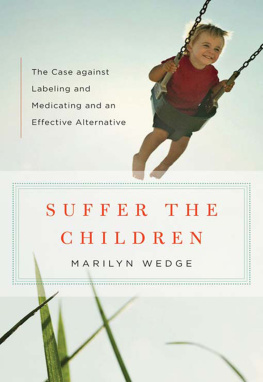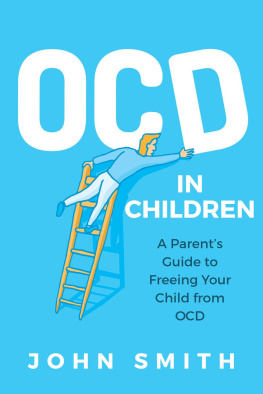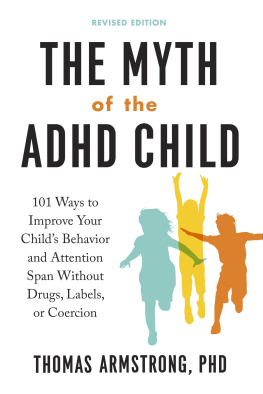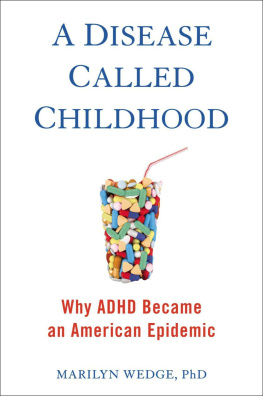For information about permission to reproduce selections from this book, write to Permissions, W. W. Norton & Company, Inc., 500 Fifth Avenue, New York, NY 10110
Wedge, Marilyn.
Suffer the children: the case against labeling and medicating and an effective alternative / Marilyn Wedge.1st ed.
p.; cm.
1. Child psychotherapy. 2. Family psychotherapy. I. Title. [DNLM: 1. Child Behavior Disorderstherapy. 2. Attention Deficit and Disruptive Behavior Disorderstherapy. 3. Child Psychiatrytrends. 4. Child. 5. Family Therapymethods. 6. Psychotropic Drugsadverse effects. 7. Unnecessary Procedurestrends. WS 350.6]
W. W. Norton & Company, Inc.
500 Fifth Avenue, New York, N.Y. 10110
www.wwnorton.com
W. W. Norton & Company Ltd.
INTRODUCTION
Do No Harm
T HIS BOOK WAS BORN on an unseasonably cool evening in January 2009. My day had been especially busybesides my usual clients I had appointments with three families that I was seeing for the first time. Id barely had time to grab a quick lunch.
As a family therapist, I view the family as the unit for therapy. This doesnt mean that the entire family comes to every session. At any given time, I might see a mother and son, two parents and their children, a teenager by herself, and even parents without their kids. I have worked with families for more than twenty years, resolving childrens problems, usually in fewer than seven sessions, and helping families heal themselves. It has been a rewarding career, and I am grateful that I have been able to help so many families regain their equilibrium and see their children triumph over seemingly insurmountable obstacles.
On this particular day, the new families had been referred by school counselors in my small community. One child was a second grader who couldnt sit still in the classroom, and the counselor thought he might have attention-deficit hyperactivity disorder (ADHD). Another was a girl of ten who had such severe mood swings that the counselor, as well as the girls frantic parents, feared she might be bipolar. The third was an adolescent boy who told me he had nothing to look forward to in life and wanted to die.
I have treated many children with symptoms like theseand worse. But what struck me that evening, as I sat down with a cup of tea to review my notes, was that before they came to see me, all the parents had taken their child to a psychiatrist, on the schools recommendation, and each psychiatrist had advised that the youngster be given medication.
I was dismayed. Of course, Im no stranger to childrens worrisome behaviors. But instead of giving them a label or a diagnosis, I view childrens symptomsunhappiness, jumpiness, moodiness, suicidal thoughtsnot as signs of a psychiatric disorder but as evidence of something wrong in the family, something that I can remedy with the right interventions.
Most parents in my practice have been anxious to avoid medicating their children. But as I was reviewing my notes that evening, a chilling thought occurred to me. I realized that in the past few months I had been seeing more and more children like the ones in my office that day, children who were already tagged as bipolar or depressed or hyperactiveeven autistic. More children were coming to me already taking medication, some of them so heavily dosed that they seemed more like sedated little adults than active children.
Why was this so? I asked myself. Why were so many youngsters taking psychiatric medications (or being told to do so) and why was the number of children coming to therapy skyrocketing? My intuition told me that the answers to these questions had something to do with our societys values, and I pondered what influences were at work beneath the surge of childhood psychiatric diagnoses.
Some years earlier, I wrote a book about my method of child-focused family therapy that was aimed at my peersclinicians and researchers in family therapy. The book was well received, but it did not carry its message to the broader audience of parents and teachers. Now, confronting a burgeoning epidemic of childrens emotional and behavioral problems, accompanied by a disturbing quick-fix response from the psychiatric community, I decided it was time to draw on my clinical experience and knowledge of child and family development to offer an alternative form of treatment. Thus, I began to write Suffer the Children .
At first I thought that the epidemic of childrens problems had something to do with life in California, the state in which I live and practice. California has a soaring divorce rate, even higher than that of the rest of the country. Our schools are underfunded and overcrowded compared to those in many other states. Social isolation is another serious problem in California, as many nuclear families lack the support of their extended families, which often live thousands of miles away. Many children here grow up barely knowing grandparents, aunts, uncles, and cousins. Also, because the cost of living in California is relatively high, more families need two incomes to make ends meet. With both parents working, children spend long hours in day care after school. All these factors could certainly put more stress on children.
But therapists in other parts of the country were telling me that they were seeing the same thing: a striking rise in childrens emotional and behavioral problems; a startling upsurge in the diagnoses of ADHD, childhood depression, autism, and bipolar disorder; and a noticeable increase in the number of young children taking psychiatric medications. The childrens mental health epidemic appeared to be nationwide.
As I began to look closely at the facts, the story became even grimmer. More than four and a half million children in the United States have been diagnosed with ADHD. The number of children diagnosed with bipolar disorder is also exploding; by 2009, more than one million youngsters had been labeled with this serious affliction, which in the past had been thought to strike only adults. Taking a child to a psychiatrist for med checks was becoming as socially acceptable as taking a boy or a girl to basketball practice or dance class. It was just one more stop on a soccer moms hectic driving schedule.
Yet, despite the social acceptability of medicating children who were inattentive or difficult to manage, many observers were raising questions about whether psychiatric drugs were really safe for children, especially in cases where the medications had not been tested and approved for pediatric use.
I dont know exactly when I first heard the term Big Pharma, but suddenly I was hearing it everywhere. I began to suspect that powerful economic forces were driving the childrens psychiatric epidemic. Developing new drugs, or re-purposing old ones and prescribing them to children, has been immensely profitable to drug companies and to the scores of psychiatrists and medical researchers who accept financial perks from the pharmaceutical industry. So potent are these medications that some of them must be labeled with a black box, a warning that the medication might have terrible side effects on children. Even more surprising to me, child psychiatrists were prescribing drugs to children without accompanying the treatment with any form of therapy or counseling. I began to wonder if child psychiatry was collectively going mad.












